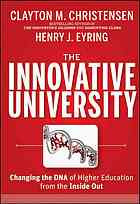The attached article is of great interest for understanding our future student pains and keep an eye on the importance of «on-line-blended education» to keep innovation high and costs low: data refer to the US but I suspect there could be a lot of similarities with the European environment.
Merry Xmas!
Innovation in Higher Education
A glance at the latest US employment figures from the Bureau of Labor Statistics reveals sharp differences in unemployment rates by educational attainment: college degree or higher: 4.3%; associate degree or some college: 8.2%; high school graduates, no college: 9.6%; and no high school diploma: 14.3%.
Moreover, while the overall unemployment rate remains over 9 percent, a recent McKinsey report found that employers are having trouble filling specific positions because they could not find applicants with the right skills.
The report projects that if economic conditions improve, there will be a shortage of 1.5 million workers with college degrees by 2020, but a surplus of almost 6 million of workers with no high school degree. It also projects a continuing shortage of workers with technical and health care skills not necessarily requiring a college degree.
Just about every such study points to a similar trend: for the foreseeable future, the US economy will need better educated workers with specific skill requirements.
Workers without a post-secondary education face a contracting set of job opportunities. Those with higher educational attainments will be in the best position to obtain good jobs with good pay.
Thus, we need to significantly increase the number of students receiving post-secondary education. However, our colleges and universities, the very institutions to which the country should turn to help us address these increased educational demands, are facing problems of their own.
Tuition costs have risen much faster than the rate of inflation and keep going up, thus making it harder for them to serve the students most in need of their services. Many educational institutions are facing financial difficulties.
The financial crisis has been aggravating the situation, at both public and private institutions. Government education budgets are under huge pressure at all levels, – local, state and national.
Incremental steps will not make much of a dent on the problem.
We need to look at higher education through the lens of disruptive innovation, argues a report published last February, – Disrupting College: How Disruptive Innovation Can Deliver Quality and Affordability to Postsecondary Education.
The report is written by Clayton Christensen, Michael Horn, Louis Caldera and Louis Soares.
Harvard Business School professor Clay Christensen is one of the world’s foremost experts in strategy and innovation. In his seminal book, The Innovator’s Dilemma, Professor Christensen articulated his theory of disruptive innovation.
It is nicely summarized in the Disrupting College report:
“Disruptive innovation is the process by which a sector that has previously served only a limited few because its products and services were complicated, expensive, and inaccessible, is transformed into one whose products and services are simple, affordable, and convenient and serves many no matter their wealth or expertise.
The new innovation does so by redefining quality in a simple and often disparaged application at first and then gradually improves such that it takes more and more market share over time as it becomes able to tackle more complicated problems.”
Before examining how disruptive innovation might apply to higher education, one needs to first articulate the key problems with the present system:
“Our country’s dominant higher education policies have focused on expanding access for more than half a century – allowing more students to afford higher education.
Yet changing circumstances mandate that we shift the focus of higher education policy away from how to enable more students to afford higher education to how we can make a quality postsecondary education affordable.
The challenge before the country also mandates a new definition of quality from the perspective of students – so that the education is valuable to them and that through it they improve their lives and thus improve the country’s fortunes, too. And if a postsecondary education is fundamentally affordable – meaning lower in cost, not just price – this will also answer the question of how to extend access by enabling students to afford a higher education.”
Why are the costs of higher education so high? According to Christensen et al, traditional colleges and universities combine three distinct objectives.
The first is research or knowledge creation.
Second is teaching or knowledge proliferation.
And third is to help prepare young high school graduates for their working lives and careers as well as to transition into independent adulthood.
In addition, quality in universities has been measured primarily by being excellent in every field of research and instruction, so they can attract top faculty and students.
Universities are thus highly complex institutions with very high costs, many of those costs going to the overhead administrative functions needed to coordinate their various missions and responsibilities.
This model worked well when universities served a relatively small, selective student population. Their high costs were subsidized by philanthropic donations and government funds.
But, as costs keep mounting and government support is getting reduced, this model may no longer work except for the small number of elite universities with large endowments and very large numbers of applicants who are willing to pay whatever it costs and from which they can be highly selective.
The model does not work at all if the primary objective becomes to provide an affordable, quality post-secondary education to a much larger number of students, and give them the appropriate skills for our increasingly demanding job market.
We need a new, disruptive model. Disruptive innovations are based on two main ingredients.
The first is a disruptive technology enabler.
This changes the rules of the game by providing a reasonably priced, good-enough service to people who could not previously afford it, and which is easily scalable to serve many more people and flexible enough to keep improving over time.
According to Christensen et al:
“Online learning appears to be this technology enabler for higher education. It is for the first time disrupting higher education – and indeed helps explain much of the rapid growth in the up-start for-profit higher education sector over the last 10 years, even as many colleges and universities have struggled financially and had to cut back.
Roughly 10 percent of students in 2003 took at least one online course. That fraction grew to 25 percent in 2008, was nearly 30 percent in the fall of 2009, and we project it will be 50 percent in 2014.”
The second major ingredient for a disruptive innovation is a business model innovation.
The key here is focus. To significantly lower costs and serve many more students, online learning should be focused on two key objectives: teaching and learning, – not research, – and highly structured programs targeted at job and career preparation.
“The historical strategy of trying to be great at everything and mimic institutions such as Harvard is not a viable strategy going forward,” observe the authors. Instead of optimizing their structure around their research capabilities, an institution wishing to offer students an affordable education must be structured to optimize the flow of students through the university.
Can such an institution offer a quality education?
It depends how you define quality, which is always the case in the early stages of a disruptive innovation.
The more prestigious traditional universities are generally those that do the best research and attract the best students. By that measure, low cost universities don’t compare since their faculties do little publishable research.
In reality, attending a prestige, research oriented university is primarily important for those students who will themselves go on to careers in research or academia, or who aspire to get the kinds of jobs for which it helps to have a degree from an elite university.
But, that is a relatively small percentage of students attending college today, let alone those not able to afford a post-secondary education at all, who would likely be the main beneficiaries of the innovations discussed in Disrupting College.
More than anything, such students want to improve their skills so they can get a better job now and have an overall better career in the future.
They are generally older, and are often not able to attend college full time because they have to work. A large percentage come from racial minorities who have been underrepresented in traditional universities.
Attending a prestigious university was never in the cards for such students, but hopefully now, they will be able to get a decent post-secondary education whenever they are ready for it.
Disruptive innovations sometimes completely replace the older version of a product or service, e.g., transistors versus vacuum tubes. But other times, they give rise to a new market segment that does not replace an older one but co-exists with it, e.g., smartphones versus PCs and tablets.
Usually two major factors determine whether the older version gets replaced or co-exists. Can the new innovation eventually perform all the functions of the older version but do so at a significantly lower price? And, can the older version reinvent itself by embracing some of the key innovations of the new product or service?
Traditional research oriented universities address a very different market segment from the one being addressed by the newer online universities optimized to provide a low cost, structured education.
“[Research] institutions of higher education remain vital – indeed those that focus on research as well as those that train people for the academy will still be critically important for the country’s future.
Most of America’s elite colleges and universities will continue to fulfill this job. But we should no longer force those institutions that are focused on teaching and learning to compete on the same metrics and play by the same rules.
Pushing these institutions to adopt a mission of knowledge creation has created institutions that have two conflated value propositions and business models – and added significant overhead costs.
We need institutions focused solely on knowledge proliferation – and need to regard those that do a good job on this dimension as being of high quality at what they were meant to do.”
However, as is always the case with disruptive innovations, the new technologies and business models should be embraced by traditional universities to help address some of the serious financial problems they are going through.
This is particularly true for those institutions not quite at the elite level who are most vulnerable to competition from the fast growing online universities.
Disrupting College is an excellent report whose provocative ideas could help address two major societal problems. First is to help us make a dent in our jobs crisis.
Better educated workers will be in a better position to obtain good jobs with good pay. An affordable post-secondary education will hopefully bring such good jobs and pay within the reach of many more workers.
And, at the same time, US higher education is facing complex challenges. Online learning might just be the kind of disruptive innovation that helps existing universities rethink many of their old assumptions and reinvent higher education. Let us all hope so.

